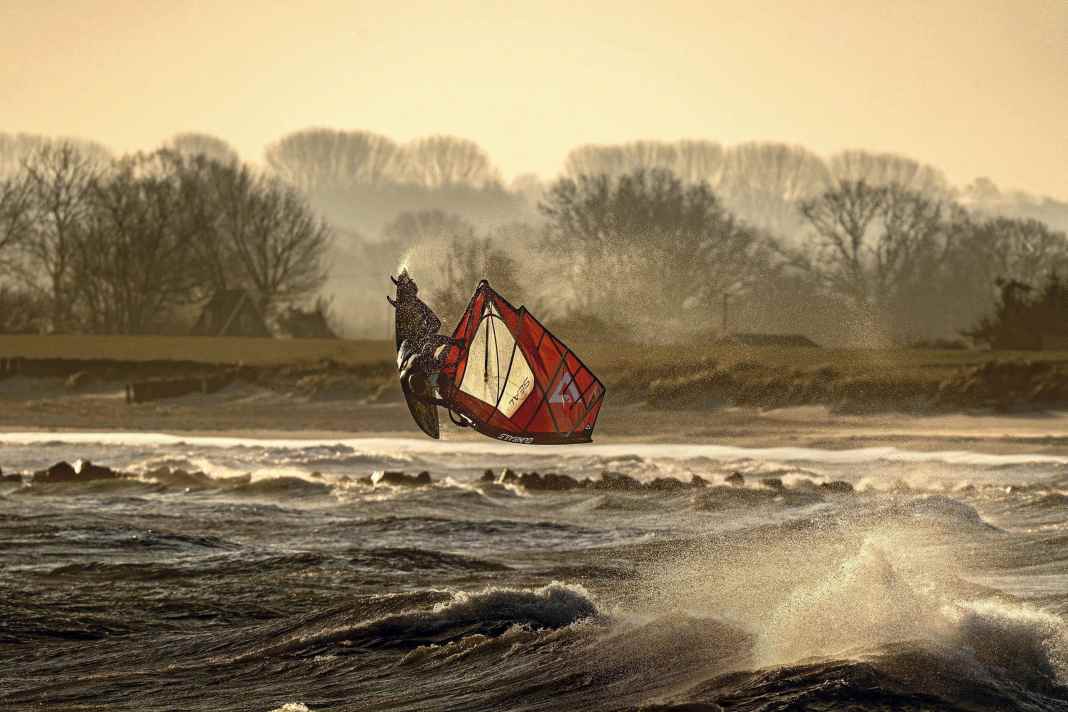





Because the difference in surface area between standard and weed models is not as great in percentage terms for short wave fins as it is for freeride fins, you can sometimes use weed fins in the wave at almost the same length as the standard fins. However, the centre of effort of the fins shifts a little further back. While this has hardly any effect on planing characteristics, control and upwind performance, the turning characteristics of waveboards are noticeably affected. The radii in the bottom turn and cutback are limited and tight hooks are noticeably more difficult. In addition, the tail gains more grip, making it more difficult to let the tail break out in the cutback - the suitability for lipslides and takas is limited.
For this reason, you should mount the weed fins in the fin boxes about one to two centimetres further forward in order to achieve comparable turning characteristics. However, if you make use of this small tuning measure, the perceived difference to standard fins is small, which is why many wave surfers simply continue to ride the weed fins even on trips to the seagrass-free North Sea. With the Maui Ultra Fins X-Twin models, there are also fins that are not purely suitable for seagrass, but still allow the annoying weed to be removed properly due to their strong tilt. Unfortunately, no other models were available for testing.
Maui Ultra Fins X-Weed
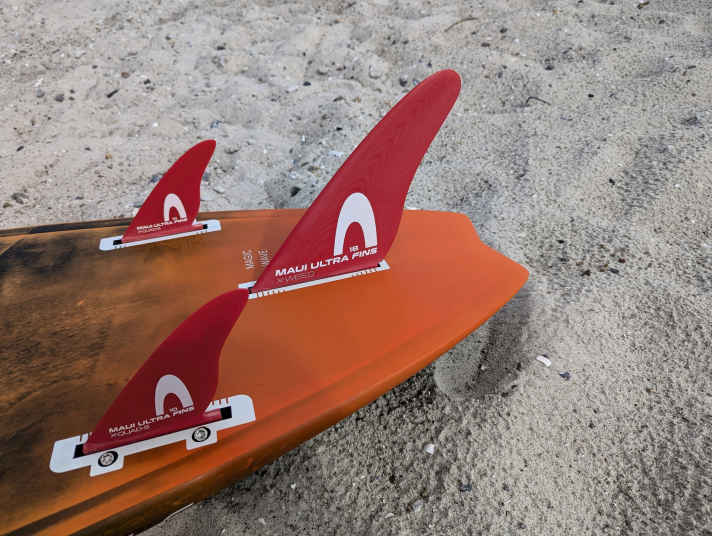
The X-Weed has an above-average surface area and a slightly thicker profile. On the water, this is reflected in very good planing performance, and the fin also takes a lot of lateral pressure and reliably pulls up on the cross without any tendency to spin out. You have to make slight compromises in terms of turning characteristics with this fin, moving it forwards can help - however, this is not possible with all boards due to the long base. All in all, we would recommend the X-Weed primarily for moderate wave and freemove boards. Ambitious wave riders would be better off opting for the more agile X-Twin R-02 or choosing the X-Weed one centimetre shorter due to its large surface area.
- Available sizes: 18-32 cm (2 cm increments)
- Box systems: Power/Slot/US
- Material: G10
- Price: 89-149 Euro >> available here
Maui Ultra Fins X-Twin R-02
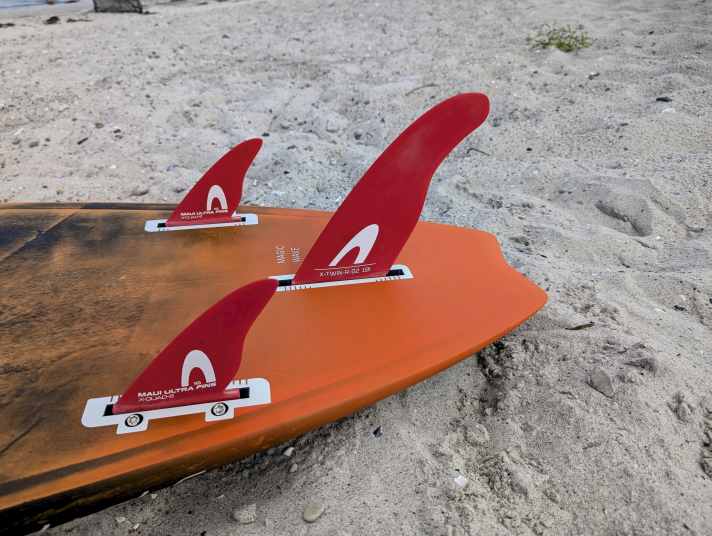
The X-Twin R is not a pure weed fin, but rather a standard fin with more rake. It has a little more flex in the tip than the X-Weed, the outline is slimmer, which means the fin has significantly less surface area than the X-Weed. Due to its steeper angle of attack, it takes longer for the fin to release on days with a lot of seaweed; pure grass models then have an advantage. Because the base is also slim, you still have the option of adjusting the position in the box. The X-Twin R-02 also gets up to speed well and is a tad looser and faster than the X-Weed when fully powered up. The turns on the waveboard are also easier to shake out of the ankle. Because the fin has a small surface area, you can orientate yourself towards the upper end of the recommended size range.
- Available sizes: 13.5-18.5 cm (1 cm increments)
- Box systemsSlot/US
- Material: G10
- Price: 54-80 Euro >> available here
Maui Ultra Fins X-Twin S
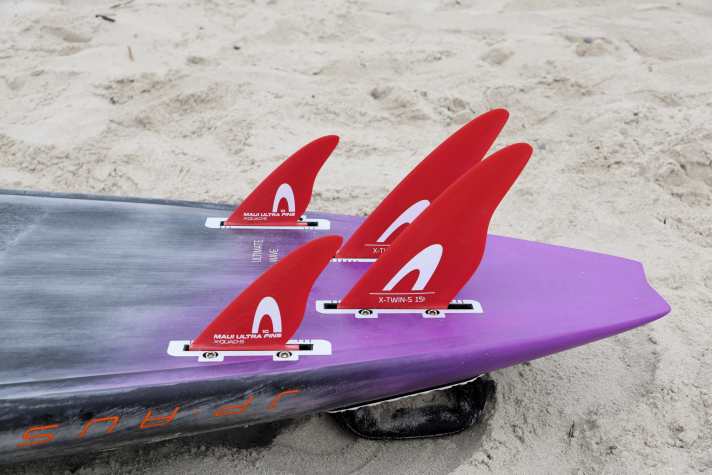
The X-Twin S from Maui Ultra Fins also reliably wipes off seaweed thanks to its 38 degree tilt angle. The riding feel is pleasingly close to that of a standard fin, as the fin takes on good pressure when planing and offers reliable counter-pressure on the cross without an increased tendency to spin out. Overall, the fin gives the board a loose and sporty, free ride. If you apply the right amount of pressure, you can deliberately bring the fin into a slide and turn it into lipslides or takas. Due to the comparatively thin profile, the X-Twin S offers a high speed potential. If you screw the fin one to two centimetres further forward into the box, you can almost make up for the small disadvantages when turning compared to the standard fin.
- Available sizes: 11.5-18.5 cm (1 cm increments)
- Box systems: Mini-Tuttle/Slot/US/Power
- Material: G10
- Price: 49-75 Euro
K4 Fins Dugong
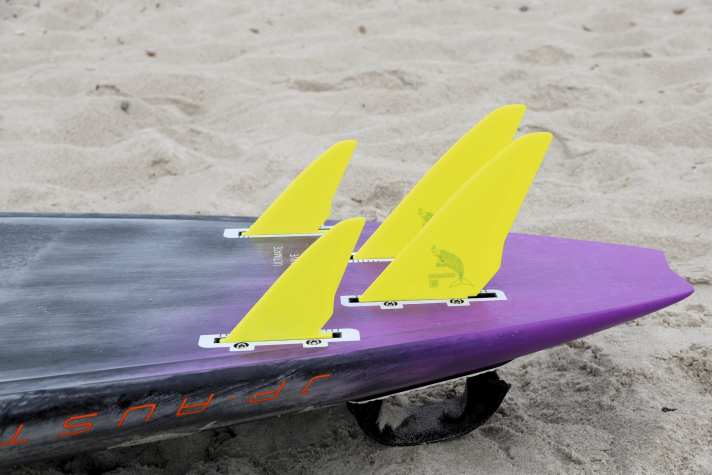
Made of glass fibre reinforced plastic, the fins have an angle of 38 degrees, which successfully wiped off seagrass in the practical test. The Dugong delivers absolutely competitive gliding characteristics and takes on a pleasing amount of pressure on the straights without breaking out. Overall, the K4 model offers a lot of control and a track-like ride. Because the profile is slightly thicker than Maui Ultra Fins, the board is not quite as lively and loose, and the fin supports controlled carved turns rather than loose lipslides on cutbacks. The turning characteristics are comparable to the Maui Ultra Fin X-Twin S, and the Dugong should also be moved slightly forwards in the box compared to the standard fin. All in all, the Dugong is a well-balanced grass fin at a more favourable price.
- Available sizes: 9/10/11/12/14/15/16/17/18/20 cm
- Box systems: Mini-Tuttle/Slot/US/Power
- Material: GRP
- Price: 23-45 Euro

